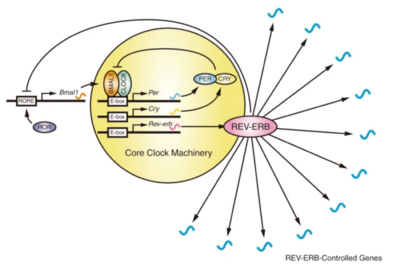Biology:Rev-Erb
| nuclear receptor subfamily 1, group D, member 1 | |
|---|---|
| Identifiers | |
| Symbol | NR1D1 |
| Alt. symbols | ear-1, hRev, Rev-ErbAalpha, THRA1 |
| NCBI gene | 9572 |
| HGNC | 7962 |
| OMIM | 602408 |
| RefSeq | NM_021724 |
| UniProt | P20393 |
| Other data | |
| Locus | Chr. 17 q11.2 |
| nuclear receptor subfamily 1, group D, member 2 | |
|---|---|
| Identifiers | |
| Symbol | NR1D2 |
| Alt. symbols | BD73, RVR, EAR-1r, HZF2, Hs.37288 |
| NCBI gene | 9975 |
| HGNC | 7963 |
| OMIM | 602304 |
| RefSeq | XM_001130839 |
| UniProt | Q14995 |
| Other data | |
| Locus | Chr. 3 p24.1 |
The Rev-Erb proteins are members of the nuclear receptor (NR) superfamily of intracellular transcription factors and key regulatory components of the circadian clock. There are two forms of the receptor, Rev-Erb alpha and Rev-Erb beta, which are each encoded by a separate gene (NR1D1 and NR1D2, respectively).[1][2]
These proteins act as key regulators of clock gene expression through transcriptional repression of Bmal1. Through their regulation of clock-controlled genes, the Rev-Erb proteins affect several physiological processes throughout the body, including metabolic, endocrine, and immune pathways.[3][4][5]
In the NRNC classification scheme, Rev-Erb is nuclear receptor subfamily 1 group D (NR1D). The name "Rev-Erb" derived by truncation from "Rev-ERBA" (Rev-Erbα), which in turn was named because it was on the opposite strand of ERBA (THRA) oncogene. The paralogous Rev-Erbβ does not seem to have anything special on its reverse strand. Older sources may use "Rev-ERBA" as the family name.[6]
The receptors are potential drug targets for non-alcoholic steatohepatitis.[7]
See also
References
- ↑ "Isolation of a cDNA encoding human Rev-ErbA alpha: transcription from the noncoding DNA strand of a thyroid hormone receptor gene results in a related protein that does not bind thyroid hormone". DNA and Cell Biology 9 (2): 77–83. March 1990. doi:10.1089/dna.1990.9.77. PMID 1971514.
- ↑ "A new orphan member of the nuclear hormone receptor superfamily closely related to Rev-Erb". Molecular Endocrinology 8 (8): 996–1005. August 1994. doi:10.1210/mend.8.8.7997240. PMID 7997240.
- ↑ "Circadian control of the immune system". Nature Reviews. Immunology 13 (3): 190–8. March 2013. doi:10.1038/nri3386. PMID 23391992.
- ↑ "Rev-erb-alpha: an integrator of circadian rhythms and metabolism". Journal of Applied Physiology 107 (6): 1972–80. December 2009. doi:10.1152/japplphysiol.00570.2009. PMID 19696364.
- ↑ "Targeting REV-ERBα for therapeutic purposes: promises and challenges". Theranostics 10 (9): 4168–4182. 2020. doi:10.7150/thno.43834. PMID 32226546.
- ↑ PMID 25066191
- ↑ Griffett, Kristine; Hayes, Matthew E.; Boeckman, Michael P.; Burris, Thomas P. (May 2022). "The role of REV-ERB in NASH" (in en). Acta Pharmacologica Sinica 43 (5): 1133–1140. doi:10.1038/s41401-022-00883-w. ISSN 1745-7254. PMID 35217816.
External links
- HZF-2alpha at the US National Library of Medicine Medical Subject Headings (MeSH)
- HZF-2beta at the US National Library of Medicine Medical Subject Headings (MeSH)
- NR1D1+protein,+human at the US National Library of Medicine Medical Subject Headings (MeSH)
Template:Receptor/signaling modulators
 |


